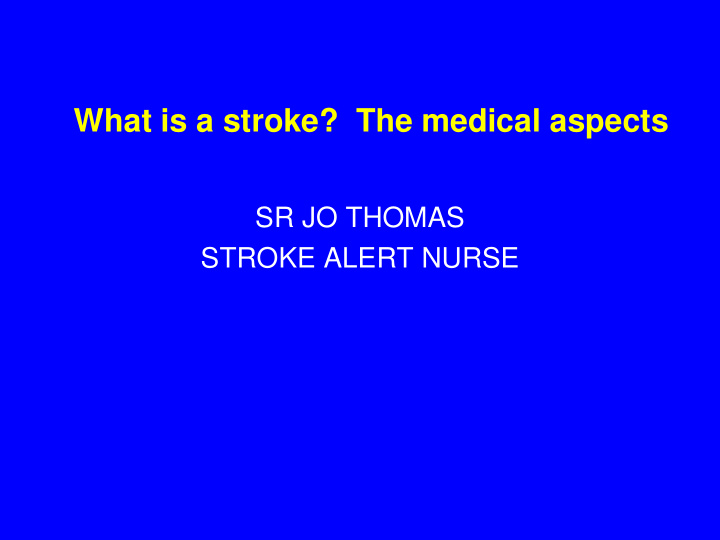



What is a stroke? The medical aspects SR JO THOMAS STROKE ALERT NURSE
Agenda • Introduction • Diagnosis • Classification • Risk Factors • Secondary Prevention • Summary • Questions?
History Pasteur had a stroke which led to a coma and almost death,with his left leg paralysed and his left arm bent and useless, he continued in his laboratory for another 25 years and founded the science of immunology
Brain attack! • Acute stroke = “brain attack” • Stroke is the brain equivalent of heart attack • Every minute matters : “time is brain” • A stroke is a serious as a heart attack • Most people who experience a stroke survive • Do not use the term “CVA”
What is a stroke? • An interruption to normal flow of blood within the brain • Ischaemic stroke (cerebral infarct) – blockage in an artery caused by a blood clot • Haemorrhagic stroke (cerebral haemorrhage) – bleeding from an artery caused by a blood vessel bursting
FAST Campaign Two million nerve cells are lost every minute that stroke treatment is delayed
Diagnosis Stroke is primarily a clinical diagnosis Warning signs: • Weakness or numbness in face, arm or leg • Difficulty speaking or understanding • Difficulty swallowing • Sudden confusion • Severe headaches • Dizziness or loss of balance • Sudden blurred or decreased vision • Sudden change of mental ability
Investigations • Blood tests – FBC, U&Es, LFT, TFT, blood glucose & cholesterol • HbA1c & urine for Alb/Cre ratio (if diabetic)
Investigations • ECG • 24 Hour ECG • To detect abnormal hear rhythm or an irregular hear beat – there is a chance that a clot can form in the heart and this clot moves to the brain to cause a stroke. • This rhythm disturbance is commoner as one gets older
Investigations • CT scan – this is a special type of x-ray scan of head to determine if a stroke has occurred and to determine whether the stroke is due to a bleed or a blockage Infarct Haemorrhage
Investigations • MRI (Magnetic Resonance Imaging ) – can be done as an alternative to a CT scan • It takes longer to do than a CT scan
Investigations • Doppler of the carotid arteries- a special scan of the blood vessels (carotid arteries) on either side of the neck. It shows “furring” or narrowing . If narrowing is severe, the patient may be referred to a surgeon for an operation to widen the artery. This is called a carotid endarterectomy
Do treatments for stroke work?
Stroke units Organized Stroke Care Saves Lives • 21% reduction in early mortality • 18% reduction in 12 month mortality • Decreased length of hospital stay • Decrease institutionalisation by 30% Acute Stroke Unit Source: Jorgenson, Stroke, 1994
Thrombolysis or “clot” busting treatment • The occlusion of an intracranial artery leads to ischaemia and then (DEA infarction of the brain D) tissue • Prompt administration of drugs that can break down thrombus could restore blood supply, thereby reducing the damage to the brain
Story…. Pre-thrombolysis ECG – pre & post thrombolysis A consultant remarked – for MI patients I saw only ECG changes but here I can see that I have reduced the physical disability by thrombolysing a stroke Post-thrombolysis patient!
Non-modifiable risk factors • Age • Gender • Ethnic group • Previous stroke • Family history of stroke
Modifiable risk factors • Smoking High blood pressure • Alcohol excess Diabetes Mellitus • Diet & Obesity Atrial fibrillation • OCP Hypercholesterolaemia • Physical exercise Carotid artery disease
Secondary Prevention (non- pharmacological) • Cigarette smoking should be discouraged and smoking cessation advice given • Heavy use of alcohol should be discouraged • Regular physical activity is recommended • A low salt, low saturated fat, high fruit and vegetable, fibre-rich diet is recommended
Secondary Prevention- (Pharmacological) • Hypertension is the greatest treatable risk factor • Systolic and diastolic are both factors • BP should be below 140/85 mmHg • <130/80 in diabetics • The majority of patients need a combination of drugs
Secondary Prevention- (Pharmacological) • Aspirin or modified release dipyridamole (16.3%) or Clopidogrel (7.3%) • Aspirin + Dipyridamole MR (37%) • AF ( warfarin - 68%, Aspirin – 21%) • Statins (20-30%)/Ezetimibe (Ezetrol) • Diabetes – (44% risk reduction with tight BP & BM control; aim BM – 4 to 10, HbA1c <7% • Surgery (stenosis >70%, good recovery from ischaemic stroke, surgery offered in 6/12)
When can I start driving again? • Refrain from driving for a month • You do not have to notify the DVLA unless there is a neurological deficit e.g. visual field defects, cognitive defects or impaired limb function • Special rules apply to Group 2 users (lorries, buses and minibuses) • Neurosurgical operation – 6-12 months off driving • Frequent TIAs or minor stroke – 3-month period free from attacks • You should see you doctor before starting to drive • Your insurance company must be informed about your stroke or TIA • It is possible to have adaptations made to your car ( REGIONAL DRIVING ASSESSMENT CENTRE 08453371540 )
Advances in treatment? • Stem cell therapy for stroke? • It allows new nerve cells to grow or regeneration of existing cells and actual recovery of function • ReNeuron's ReN001 A vial containing brain stem cells produced by ReNeuron's cloning technique
Summary • There are two types of stroke – Ischaemic & haemorrhagic • Good evidence that stroke units and thrombolysis reduces length of stay, disability and placement in an institutional care • Patients undergo investigations to establish the type of stroke and to address risk factors • Stroke patients are prescribed medicines to prevent future strokes • We should encourage them to lead a normal & safe life
“If you don’t know where you’re going you won’t know how to get there” Mark Twain Thank you
Recommend
More recommend